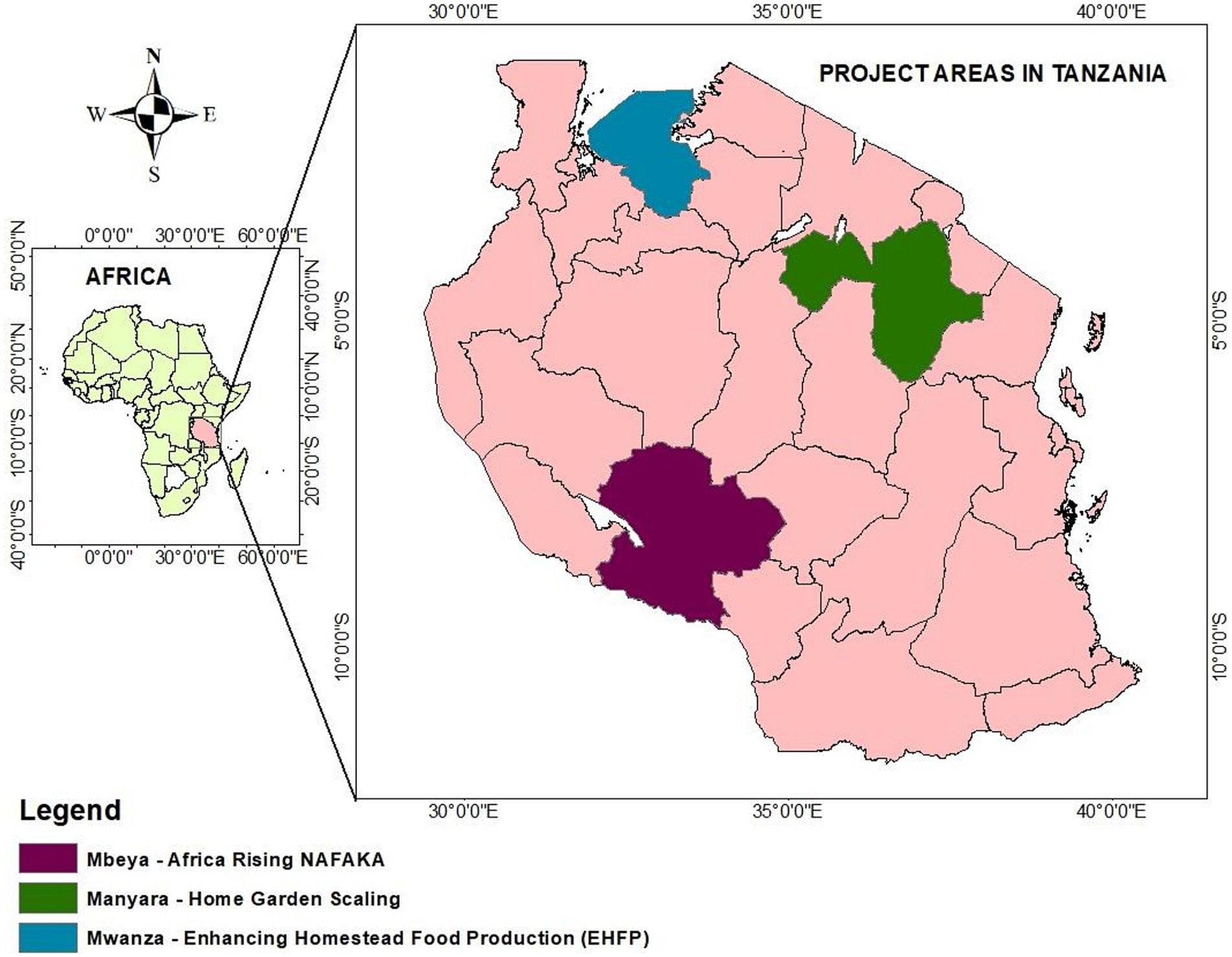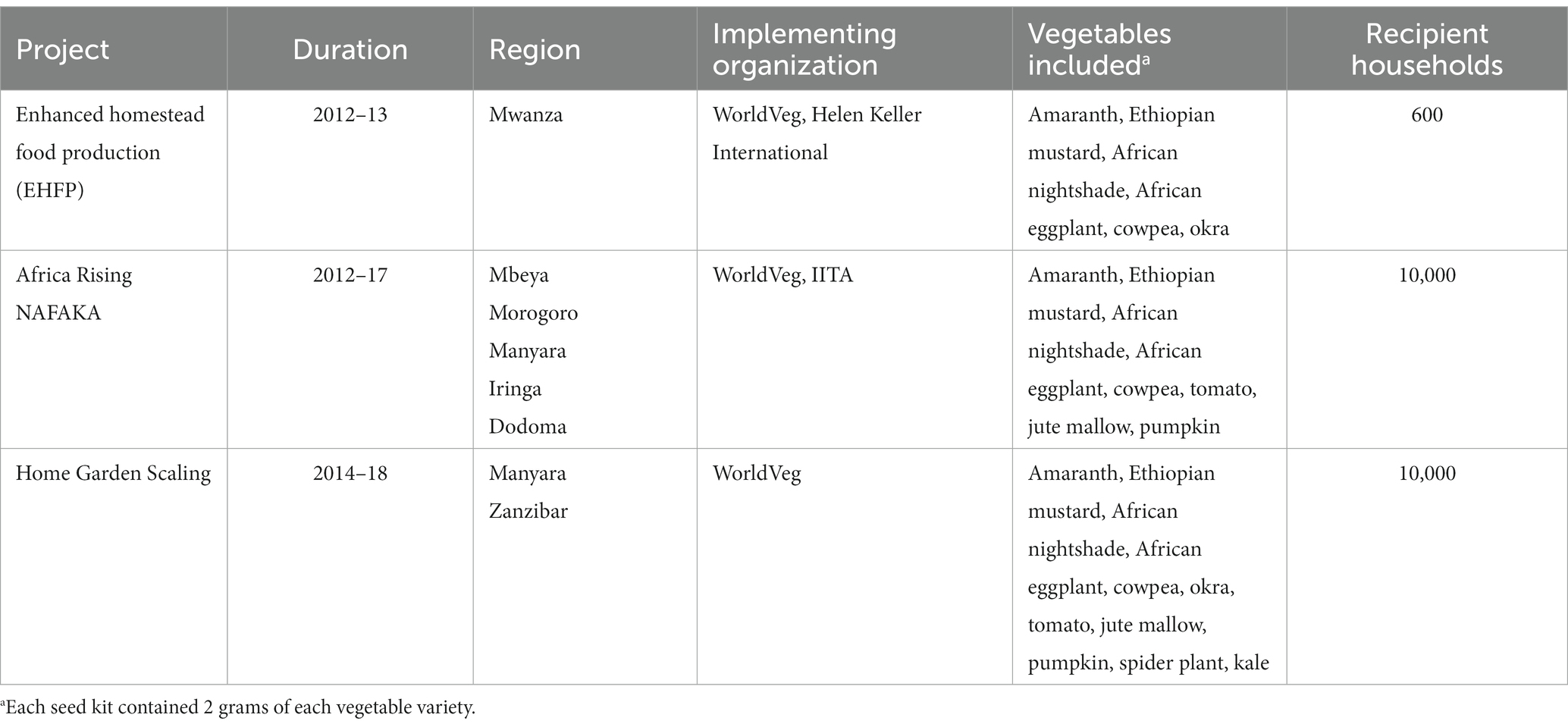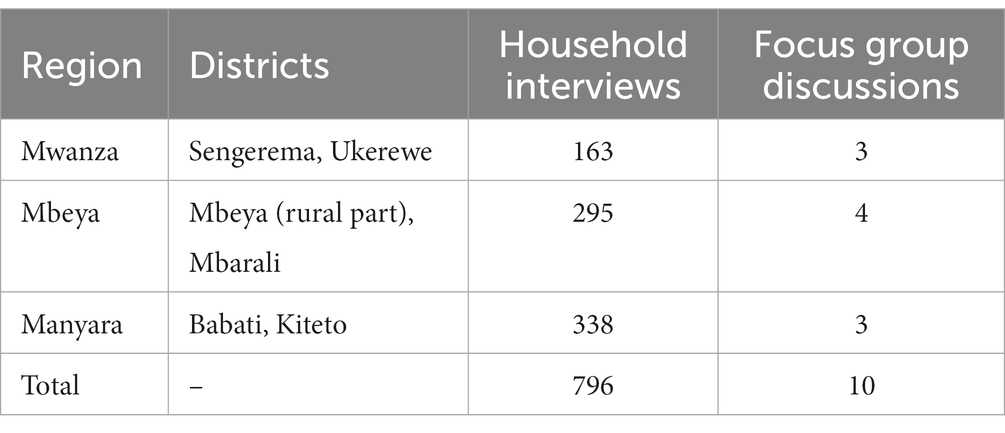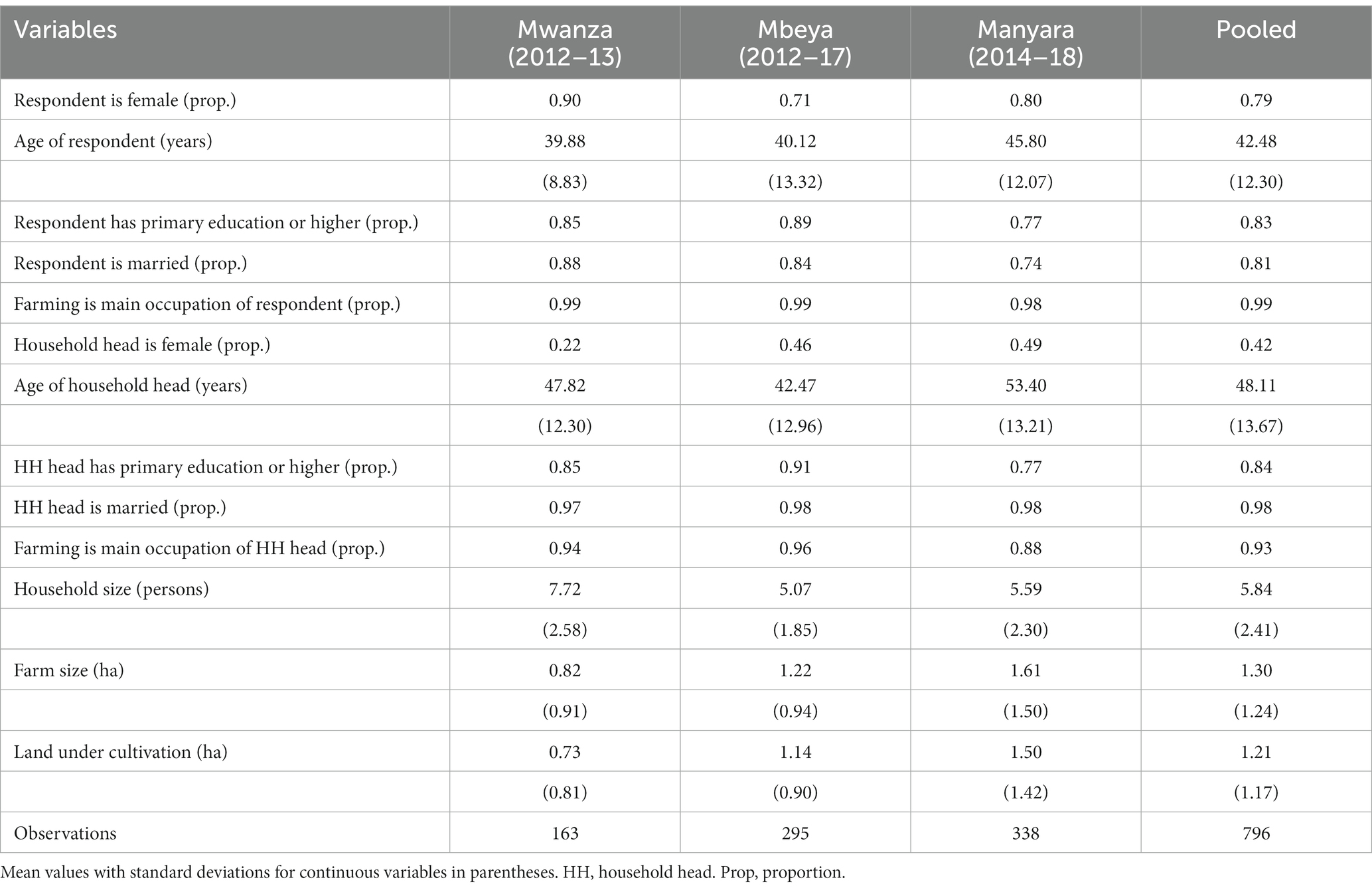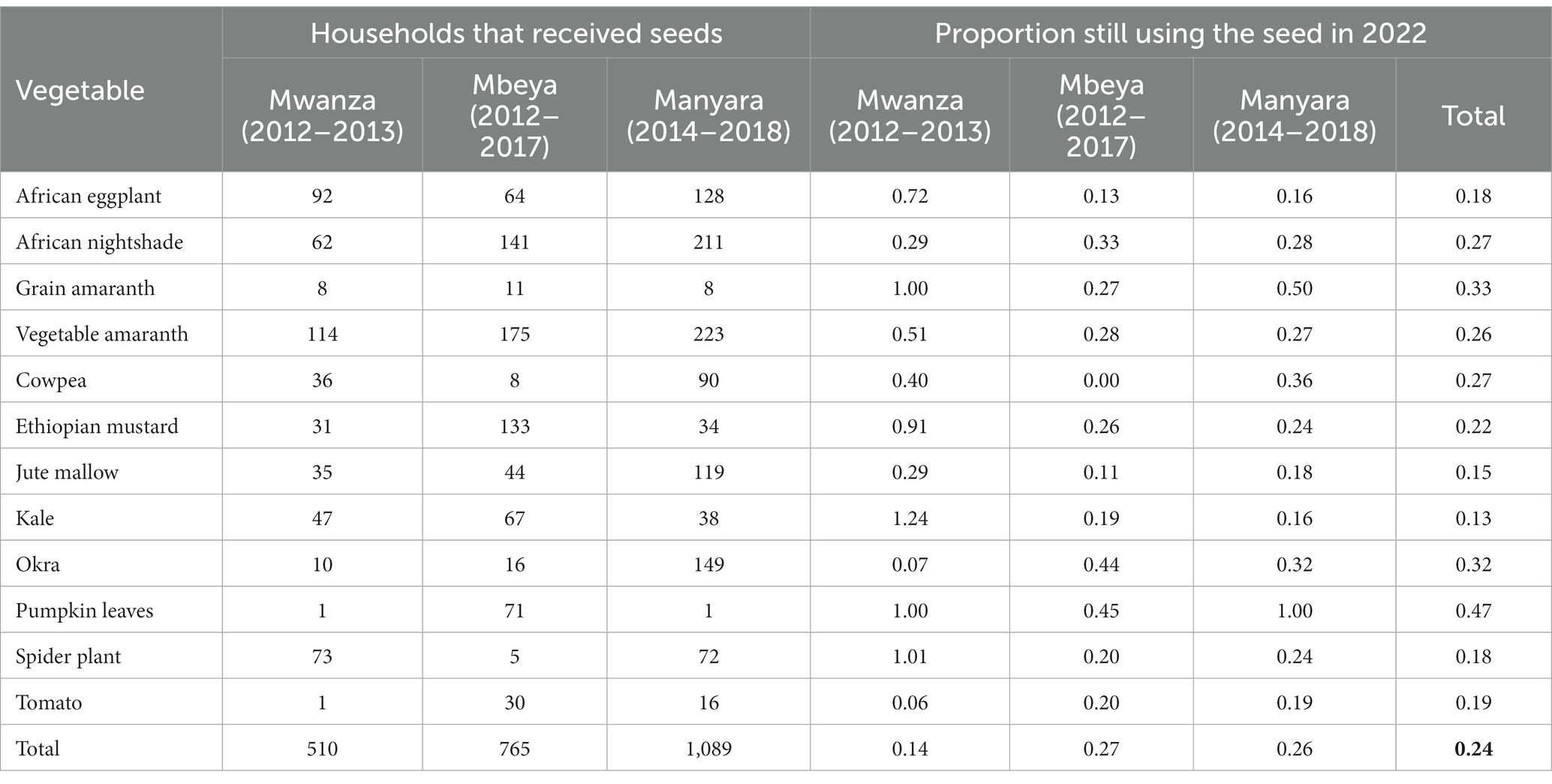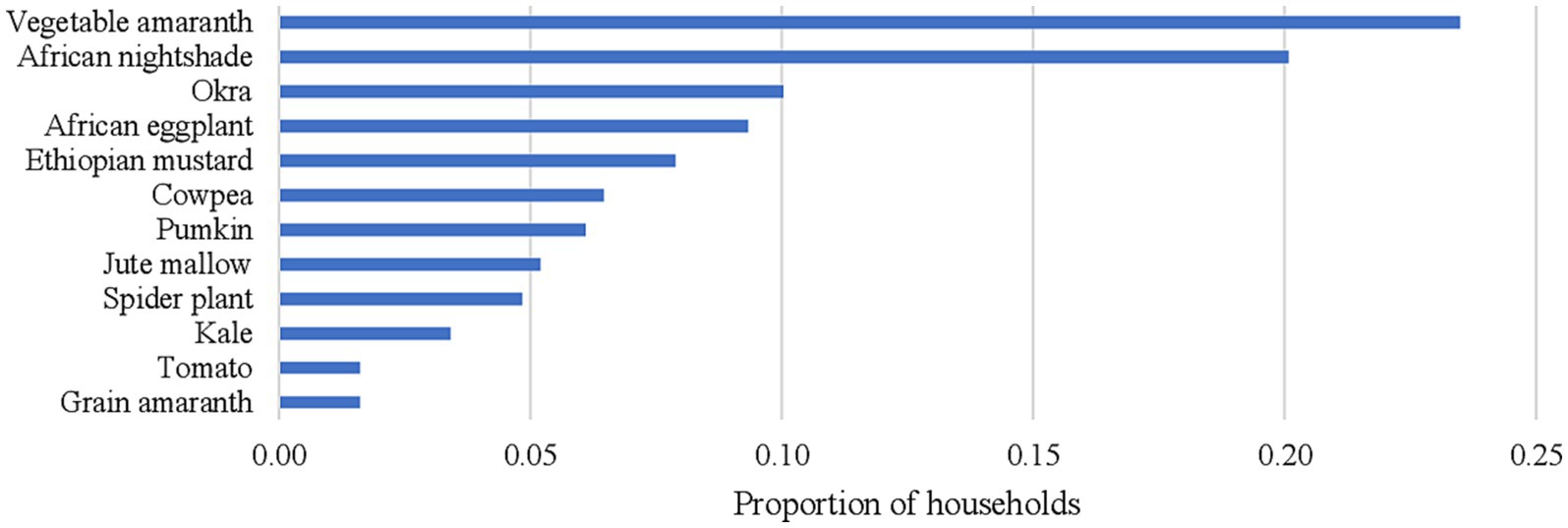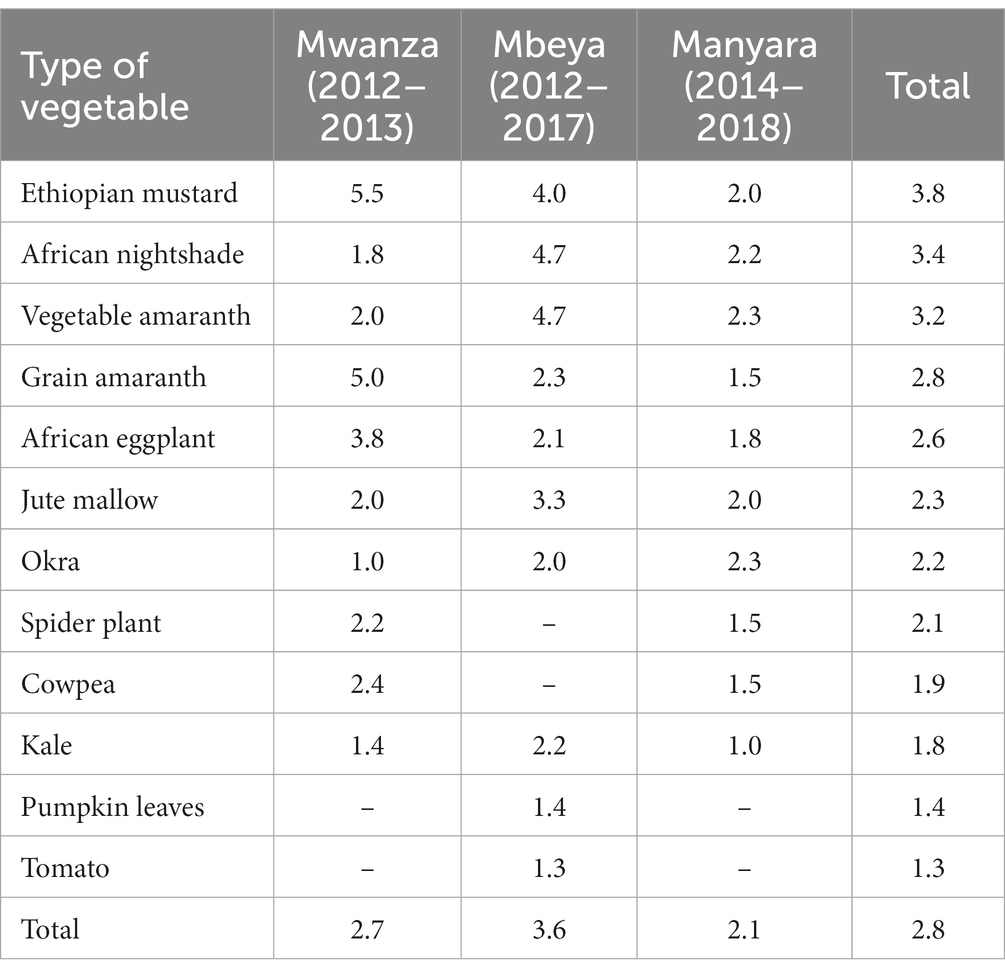- 1World Vegetable Center, Eastern and Southern Africa, Duluti, Arusha, Tanzania
- 2World Vegetable Center, East and Southeast Asia, Bangkok, Thailand
The one-time distribution of vegetable seed kits containing small (2 grams) samples of improved varieties of traditional and exotic vegetables can potentially increase vegetable production and consumption among poor rural households, but evidence is lacking. This study therefore analyzed the extent to which recipients of vegetable seed kits in Tanzania have sustained the use of introduced vegetable varieties. Data came from a random sample of 796 households who directly or indirectly received seed kits between 2012 and 2018, complemented with 10 focus group discussions among seed kit recipients. The results show that 24% of direct recipients are still reproducing the seed of introduced vegetable varieties after a period of 5–10 years, with variation across varieties and the time seed was introduced. The success rate was higher for traditional vegetables than exotic vegetables and higher for women than men. Reasons for not continuing seed use were the lack of knowledge on seed saving, problems with pests and diseases, and reduced germination. Hence, the sustainability of small seed kit distributions can be enhanced by accompanying them with adequate training on seed saving and seed storage.
1 Introduction
Evidence shows that malnutrition, especially micronutrient malnutrition, remains a large problem in many low- and middle-income countries (LMIC) (FAO, IFAD, UNICEF, WFP, and WHO, 2022). This is largely associated with the prevalence of low-quality diets that often lack nutritious food. Increasing the consumption of vegetables (and other nutritious food) is considered one of the sustainable approaches to address nutritional challenges in LMICs (FAO, IFAD, UNICEF, WFP, and WHO, 2022). As vegetables are often not available locally, there is a need to stimulate local production alongside promoting demand (Schreinemachers et al., 2017). It has been projected that by 2050, vegetable production needs to increase by 75%, while minimizing losses along supply chains, to supply enough for healthy diets (Willett et al., 2019). Farmer access to quality seed is one important innovation necessary to achieving this. However, most seed interventions remain focused on cereals, which are important to address hunger, but do not address micronutrient malnutrition (FAO, IFAD, UNICEF, WFP, and WHO, 2021, 2022; Nabuuma et al., 2022).
In Africa, the formal vegetable seed sector relies heavily on the import of vegetable seed from outside the continent (Schreinemachers et al., 2021). The focus is on exotic vegetables (e.g., tomato, chili, lettuce, carrot) rather than local vegetables (e.g., African nightshade, cowpea, amaranth) (van de Broek, 2015; Access to Seeds Foundation, 2016; Ayenan et al., 2021). Yet, the demand for local or traditional African vegetables (TAVs) has grown significantly as a result of increased nutritional knowledge and potential for income (Ruel et al., 2005; Mwangi and Kimathi, 2006; Onim and Mwaniki, 2008). Many TAVs are excellent sources of dietary fiber, vitamins and minerals that are essential for health (Kwenin et al., 2011; Ukegbu and Okereke, 2013). Well adapted to local climates, many TAVs can be grown year-round (Weinberger and Msuya, 2004). Despite this, production of TAVs is constrained by many factors including the low availability of quality seed and other production-related risks, lack of appropriate market information, and high postharvest losses (Afari-Sefa et al., 2015; Ayenan et al., 2021; Kansiime et al., 2021). Enhancing access to quality seed of both exotic and TAVs provides smallholder farmers with more alternatives in terms of vegetable varieties that suit their preferences and are adapted to local conditions. This is important for improving nutrition and increasing income, while ensuring resilience to climate change.
The recent past has seen more effort by public and private organizations in promoting vegetable production and consumption. Multiple strategies have been used to ensure farmers’ access to improved vegetable seed varieties either through direct seed supply to farmers (Schreinemachers et al., 2016; Daidone et al., 2017; Pincus et al., 2018) or indirectly through seed training and credit access, farmer seed enterprises, or participatory plant breeding (Hallman et al., 2003; Galié, 2013; Rajendran et al., 2016; Nabuuma et al., 2022). The World Vegetable Center (WorldVeg), an international agricultural research center, has distributed vegetable seed kits directly to farmers in East Africa since the early 2000s. According to Lammerts van Bueren et al. (2018), the introduction of crop cultivars without embedding them into existing functional formal systems does not sustain beyond a project period. While impact studies were conducted on some of the WorldVeg projects shortly after households received seed kits and training (e.g., Depenbusch et al., 2022), it remains unknown whether recipients were able to regenerate the seed over the longer-term.
The objectives of the study were to assess: (a) whether recipients of vegetable seed kits have continued using the seed in the long-term; (b) if and how seed was shared within the community and beyond; and (c) the long-term effects (both positive and negative) of seed kit distribution. This evidence is important to inform the design of future projects that intend to distribute vegetable seed in Tanzania and elsewhere. Data for this study come from a survey of households that received seed kits from three projects implemented in Tanzania between 2012 and 2018 complemented with qualitative data from focus group discussions.
2 Data and methods
2.1 Intervention
We created a list of all WorldVeg projects that had distributed vegetable seed kits in Tanzania (Supplementary Appendix Table A1). The list had 11 projects that ran between 2010 and 2020. From this we selected three projects that had distributed large numbers of seed kits, representing different parts of Tanzania, and for which contact data of recipients were available: the Home Garden Scaling project in Manyara (2014–2018), the Enhancing Homestead Food Production (EHFP) project in Mwanza (2012–2013), and the Africa Rising NAFAKA project in Mbeya (2012–2017) (Figure 1). Table 1 summarizes key data of the selected projects. All projects were funded by the United States Agency for International Development (USAID). Vegetable varieties distributed through these projects were selected for yield, disease resistance and consumer preference under local conditions. Priority was given to vegetables dense in micronutrients but also liked by local consumers. The projects targeted smallholder farmers in rural areas and prioritized the inclusion of households with women of reproductive age with children under 5 years.
All varieties were open-pollinated allowing farmers to regenerate their seed. The three projects provided seed as part of training on home gardening aimed at improving household nutrition and diversifying income. The home garden training included agronomic practices such as site selection, seed bed preparation, pest and disease management, and soil fertility management alongside nutrition topics such as vitamins and minerals contained in different vegetables, the body functions of different vitamins and minerals and cooking preparations on how to optimally preserve food nutrients. The garden training always included aspects of seed saving. Seed kits also contained brief instructions on good agricultural practices and information on their nutritional value. The seed kits included 2 grams of seed per vegetable variety, and on average 4 to 5 different vegetable varieties were included in each seed kit. All projects involved one-time distributions of seed kits, so households did not receive a regular supply of seed to avoid dependency or crowding-out of local seed enterprises (Stoilova et al., 2019).
2.2 Analytical approach
The study focuses on the continued use of seed varieties by recipients of vegetable seed kits. Our variables of interest are the use of seed varieties, seed saving, and seed sharing through social networks. These variables are straightforward to collect using a structured questionnaire on a random sample of project participants. This is not an impact study as we do not have a control group of households and we do not have pre-intervention (baseline) data. We complemented the questionnaire data with focus group discussions to gain a deeper understanding of how seed was shared within the communities.
2.3 Data collection and analysis
Two districts were selected from each region: Babati and Kiteto in Manyara, Ukerewe and Sengerema in Mwanza, and Mbeya and Mbarali in Mbeya. Sample villages were randomly selected from a list of all project villages per district. From each village, households were randomly selected from the list of recipient households with the sample size being proportionate to the share of the village in the total population of the selected districts.
Quantitative data were collected between July and August 2022 using a structured questionnaire survey employing computer-assisted personal interviews. Interviews took 15–30 min to complete. A total of 796 households were interviewed, of which 703 were primary recipients of seed kits and 93 were secondary recipients who received seed kits from others through informal seed sharing (Table 1). Primary recipients were asked to identify secondary recipients, but not all could be interviewed because of their unavailability and distance. Quantitative data was analyzed using STATA software.
Questions related to general household characteristics, main crops and vegetables cultivated, vegetable seed varieties received under different projects, a list of vegetable varieties used currently, and seed sharing. For each type of seed contained in the seed kit, we asked the respondent whether they had received, sown, and harvested it and whether they had saved the seed and shared it with others. The respondent was the person in the household who was most familiar with the seed kit received (Table 2).
Qualitative data were collected using Focus Group Discussions (FGDs). The purpose was to gain a deeper understanding of the use of vegetable seed, sharing, impact, challenges, and potential opportunities. The FGDs comprised at least one adult from households that received seek kits under any of the three projects. A checklist of questions was formulated to guide the discussions. FGDs were conducted by a trained facilitator while another researcher took notes. Each FGD took between 1.5–2 h to complete. Qualitative data were analyzed using content analysis (Table 3).
For both the personal interviews and the focus group discussions, the researchers explained the purpose of the study to the respondents before the interview and asked for their verbal consent to participate. Participation in the study was voluntary and considered to impose no risks to participants. The study was exempted from full ethics review by the Institutional Biosafety and Research Ethics Commission (IBREC) of the World Vegetable Center (Registration nr. 2022–015).
3 Results
3.1 Sample characteristics
The three projects targeted women farmers and, as a result, 79% of the respondents were female although 58% of the households were male headed. The average age of the household head was 48 years. Of the household heads, 85% had completed at least primary education. The average household had 6 persons and 1.3 hectares (ha) of land of which 1.2 ha was under cultivation.
3.2 Use of vegetable seed kits
Respondents were asked to list the vegetable varieties they had received from the respective projects. Table 4 shows the proportion of primary recipients who mentioned selected vegetable crops and whether they have continued using these seeds. The results are based on vegetable crops of which seed was distributed in the three projects as shown in Table 1. On average, 24% of farmers continued using the varieties of seed that they received between 2012 and 2018. This percentage varied by vegetable type and time of receipt. For instance, for the period 2012–2013, 114 respondents reported to have received amaranth seed, of which 19% had continued using the seed at the time of the survey. During the same period, 92 respondents had received African eggplant seed and 25% continued to use it. Yet, of the 62 households that had received African nightshade seed, only 8% had continued to use it.
During the period 2012–2017, 175 households had received amaranth seed, 141 received African nightshade while 133 received Ethiopia mustard. At the time of the survey, 28% of farmers were still using seeds of vegetable amaranth, 33% of African nightshade, and 26% of Ethiopian mustard. In the period 2014–2018, more households received seeds of different vegetable crops than in the preceding periods. Also, there were more households still using the seeds distributed to them during this period than the previous two periods. At the time of the survey, over 20% of farmers were still using seeds of Okra (32%), African nightshade (28%), vegetable amaranth (27%), and Ethiopian mustard (24%).
A probit model regression with continued use of seed (0/1) as dependent variable shows that continued use of vegetable seeds was significantly influenced by gender and education level of the household head, and the type of vegetable seed received (Supplementary Appendix Table A2). Women headed households were more likely to continue using the seed kits as compared to men headed households. Household heads with higher level of education were also more likely to sustain seed use, especially seed of amaranth and African nightshade. In terms of vegetable crops, households were more likely to sustain seeds of African nightshade, vegetable amaranth, and okra as compared with African eggplant. Except for okra, the coefficient for year received is not significant in any other model, implying that there is no decline in use of seeds distributed over time.
3.3 Vegetable production
Chinese cabbage is the most popular vegetable, cultivated by 56% of survey respondents (Figure 2). This was followed by amaranth (53%), African nightshade (34%), pumpkin leaves (27%), and kale (21%). The proportion of households cultivating these vegetables varied across regions.
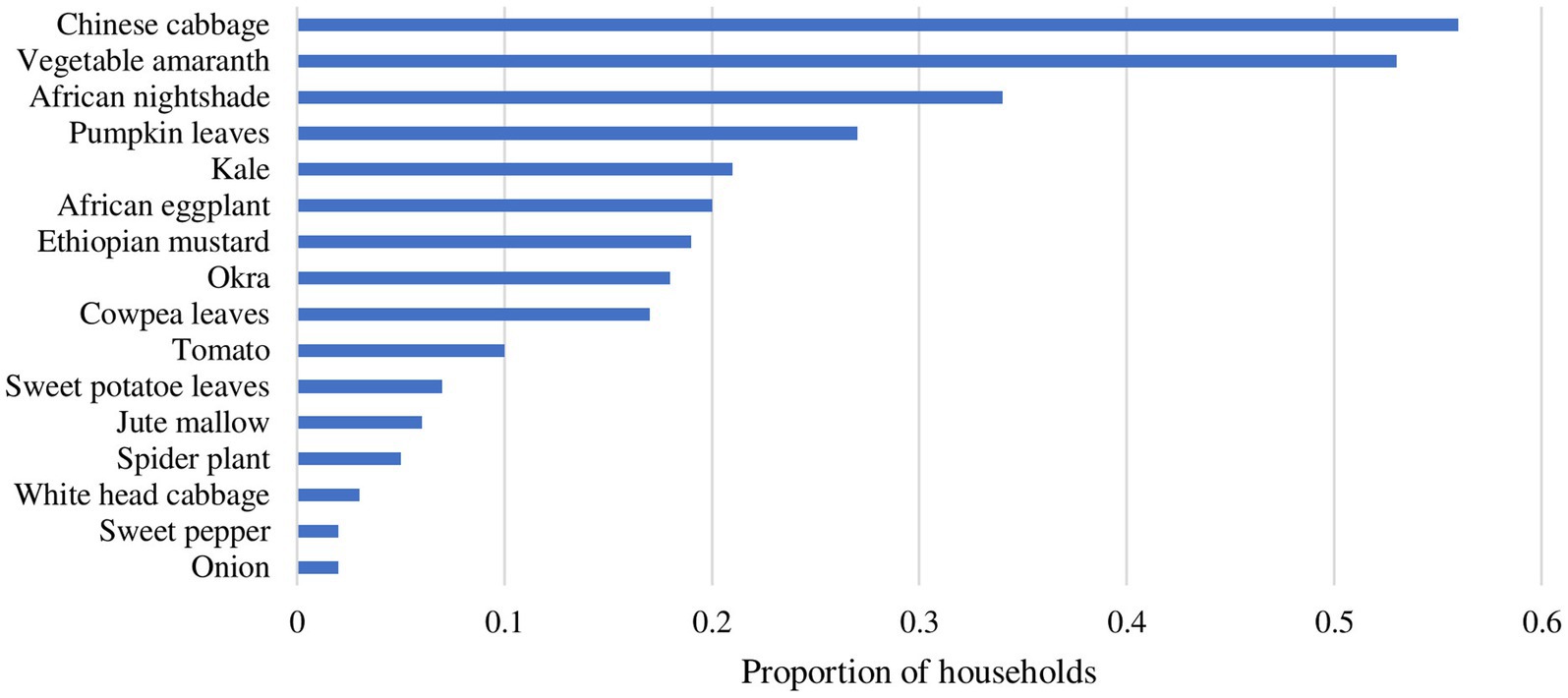
Figure 2. Vegetable species for which the seed was used by households, in proportion of households, Tanzania 2022.
In Mwanza, amaranth (83%), eggplant (44%) and Chinese cabbage (41%) are the most popular vegetables produced and consumed. Most vegetable seeds are purchased from agro-dealers, except for cowpea and spider plant which are often recycled from seed provided by the project. The production of high value crops like tomatoes is dominated by men while women mostly produce leafy vegetables. The qualitative data collected through FGDs shed more light on the use of seed. FGD participants mentioned that leafy vegetables are easier to produce because seed is more accessible, and they are more marketable in this region compared to fruit vegetables which have longer value chains. In addition, fruit vegetables were perceived to have high needs in terms of inputs and labor time demanded in production.
In Mbeya, Chinese cabbage is the most cultivated and consumed leafy vegetable followed by Ethiopian mustard. Seeds of most traditional African vegetables are obtained from agro-dealers, projects, other farmers, or own saved seeds, but seed of tomato and Chinese cabbage is mostly purchased from agro-dealers. According to the qualitative data, preference for purchased seed was mainly attributed to: (i) the low germination rate for recycled seeds, especially tomato; (ii) farmers’ perception that hybrid seeds have better resistance to pests and diseases; and (iii) limited knowledge of seed production of some crops. Like in Mwanza, FGD participants mentioned that men tend to produce fruit vegetables (e.g., tomato, okra, African eggplant, sweet pepper) on larger plots for the market while women tend to produce leafy vegetables (TAVs and Chinese cabbage) on smaller plots mainly for home consumption. According to participants, these differences are attributed to the fact that: (i) men prefer high value crops that fetch higher market prices; (ii) production of fruit vegetables is time and labor intensive, which makes it difficult for women given their other multiple responsibilities; (iii) fruit vegetables, especially tomato and sweet pepper, need more finance to buy inputs than leafy vegetables; and (iv) leafy vegetables, especially TAVs, require less inputs making them more suitable for women.
In Manyara, Chinese cabbage, Ethiopian mustard, and amaranth were mentioned as the most popular vegetables. Seed of commercial vegetables like tomato, Chinese cabbage, and kale are mostly purchased from agro-dealers while seed of other vegetables is recycled. Different from Mbeya, farmers in Manyara preferred recycled seeds because: (i) it reduces seed purchasing costs; (ii) they did not see any difference in performance between purchased and recycled seeds; (iii) poor quality of purchased seed (what is on the package is sometimes different from what actually grows); (iv) certain recycled seeds have better resistance to pests and diseases than purchased seeds; (v) they can get income from selling seed; and (vi) they are able to maintain their preferred variety through seed saving. In Babati, the role of men and women in vegetable production is seasonally dependent. Women do most of the vegetable production in the rainy season while men do most vegetable production in the dry seasons, under irrigation. This is because women’s plots are farther away from a water source requiring them to travel long distances to fetch water for irrigation. One female participant explained during the FGDs “Men cultivate along sources of water and irrigate vegetable farms at night, something that is difficult for us to do.” Like in Mwanza and Mbeya, men produce more commercial vegetables (e.g., tomatoes, onions, eggplant, okra, and cabbage) while women produce more leafy vegetables (e.g., sweet potato leaves, cowpea leaves, amaranth and African nightshade) mainly for home consumption, and a small proportion for sale.
3.4 Seed production and sharing
Respondents were asked in the survey if they ever produced seeds from what they were given by the project or shared these seeds with other farmers. Most of the respondents have produced seed of amaranth (54%), African nightshade (39%), and African eggplant (25%) (Figure 3). These were also the seeds that were mostly shared by households (Figure 4).
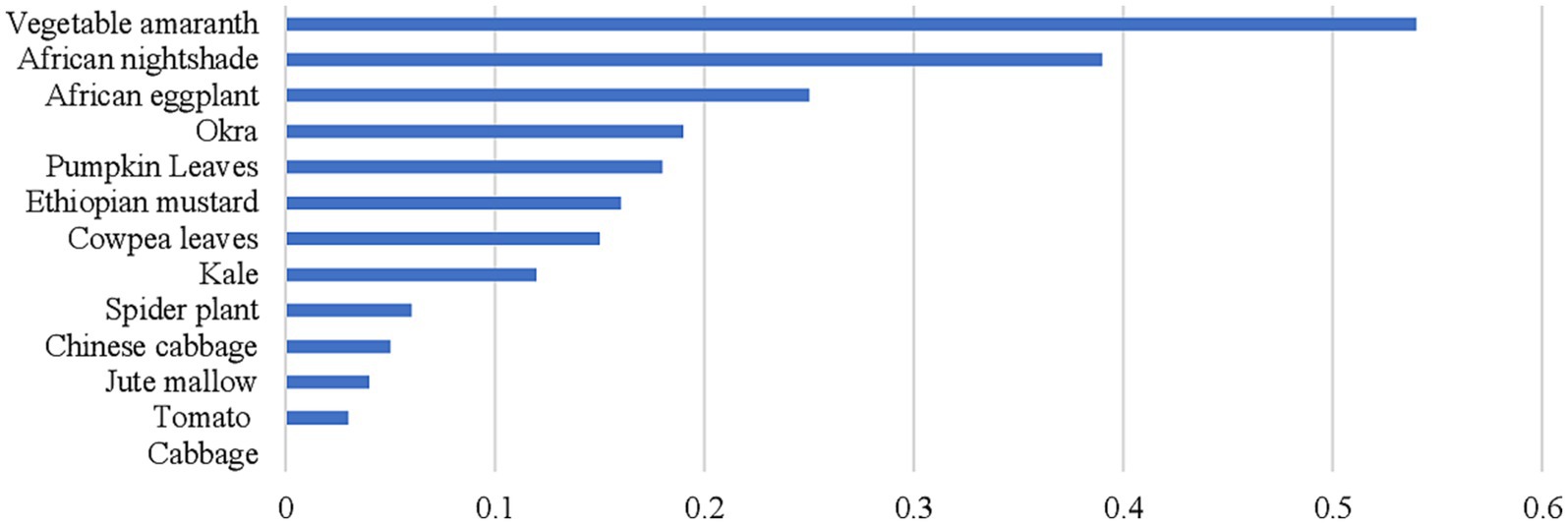
Figure 3. Vegetable species of which seed was reproduced by households, in proportion of household, Tanzania 2022.
On average, each seed kit recipient had shared the vegetable seed with about three other farmers who had not received seed kits directly from the project (Table 5). This varied across vegetable species and projects. Seed sharing was highest in Mbeya in the Africa Rising NAFAKA project, and lowest in Manyara in the Home Garden Scaling project.
Farmers reported in the FGDs that the seeds produced were either used for sowing during the subsequent production season, shared with other farmers, or sold. Seed recycling was common across all the three regions, especially for amaranth and African eggplant (Table 6). In Mwanza, farmers recycled seed of amaranth, cowpea, and spider plant. This was attractive to farmers because: (i) seed production for these vegetables is easy; (ii) the seed varieties were not easily available in local shops; (iii) the recycled seed had higher yield and better resistance to drought than purchased seed; (iv) seed saving reduced input costs; and (v) the varieties were found to be better tasting, especially those of cowpea and spider plant. One farmer said “The taste of the spider plant variety brought by the project is very nice compared to our local variety and is liked by my children. This is why I save the seeds in my bag.” However, in Sengerema district, the recycled seed of African eggplant was observed to produce smaller fruits over time. According to FGD participants there, seed production, saving and sharing was a challenge, which was attributed to lack of knowledge on seed production and saving. Although all seed kit distribution was accompanied by training on seed saving, some farmers felt it was insufficient.
In addition to amaranth and African eggplant, farmers in Mbeya also recycled seed of African nightshade and Ethiopian mustard. Farmers mentioned that seed of these vegetables was recycled because the varieties are less susceptible to pests and diseases, and the seed is easier to produce and store as compared to the other vegetables in the seed kits (cowpea, tomato, jute mallow and pumpkin). For instance, it was difficult to recycle seed of pumpkin and jute mallow because of poor performance of the varieties, which was associated to cold weather in some areas. Even so, recycled seed was observed to have decreased germination and harvesting period over time. While referring to seed of Ethiopian mustard, African nightshade, amaranth and African eggplant, a farmer in Mshele village, Mbeya region, said, “After 2 years of using the seed, I could not harvest over a long period like before as the new seed produced flowers early.” Some farmers also observed yields go down over time. In addition, farmers had challenges in saving seeds because they did not have adequate knowledge. Although seed distribution was complemented with training on seed saving, farmers felt that it was not enough.
In Manyara, farmers recycled seeds of amaranth (Madiira 1), African eggplant, and Ethiopian mustard. Challenges related to seed saving included: (i) inadequate training on seed production and saving; (ii) destruction of plants by pests before seed maturation; (iii) cold weather; and (v) seed spoilage during storage. Seed sharing was also common in this region.
3.5 Perceived benefits of seed kits
Overall, participants in the focus group discussions perceived multiple benefits from the seed kits, including: (i) increased household consumption of vegetables, and greater dietary diversity; (ii) introduction of new vegetable varieties; (iii) improved health outcomes in the households; (iv) increased income from the sale of vegetables and vegetable seed, and (v) increased knowledge on vegetable production, which are further explained in the following.
According to the focus group participants, there was a reduction in the number of stunted children in Mbarali district (confirmed by a report from the ministry of health), which FGD participants attributed to increased vegetable consumption. A farmer in Sengerema district said, “Consuming vegetables from my home garden has improved my eyesight,” another farmer in Manyara said, “Eating a diversity of vegetables from my home garden healed me from anemia. I will forever be grateful to that intervention.”
Farmers pointed out that some of the vegetable varieties introduced by the project had not been available before. For instance, farmers in Mbeya said the varieties of jute mallow, African eggplant (whitish color, less bitter) and Ethiopian mustard (improved variety harvested by plucking leaves) were new to them. One farmer said “We had never seen jute mallow seeds until the project brought them. The variety was better than our indigenous varieties that we used to grow on our fields, but it is no longer available.” Another farmer said, “Seeds of Ethiopian mustard variety received from the project were new to this area, but are not available in the markets. This variety is loved for its taste and long harvesting period. If the variety was still around, it could have replaced the older variety (often harvested by uprooting).” The new amaranth varieties were observed to have high germination rates, high leaf yields, and were more marketable compared to other local varieties. In Mwanza region, jute mallow and a broad-leaved amaranth were new, especially in Ukerewe district. One farmer said, “After introduction of the improved amaranth varieties through the project, the traditional varieties faded away. This is because the new variety was high yielding, more marketable, and had good taste.” A broad-leaved African nightshade variety, and improved okra variety, amaranth (Madiira 1) and jute mallow were new to Manyara region. Local varieties of amaranth and African nightshade decreased after the introduction of these improved varieties. Local jute mallow is still available but less used than the new varieties.
Farmers experienced an increase in sale of vegetables and vegetable seed. For instance, according to the FGD participants, over 70% of the current vegetable farmers in Mbeya rural district started producing vegetables because of the Africa Rising NAFAKA project. Farmers also noted an increase in their knowledge on vegetable production. A farmer in Mwanza said: “Through the demonstration plots organized by the project facilitators, I was able to learn for the first time how to grow vegetables properly.” Another farmer said: “Through the training and vegetable seed kit I was given, I learnt how to prepare tasty vegetables while preserving nutrients.”
3.6 Challenges associated with seed kits
Challenges associated with vegetable seed kits mentioned during the FGDs included: (i) farmers were not familiar with the names of the seed varieties that were given to them, which made it difficult to buy the same varieties in the market; (ii) poor performance of some of the vegetable varieties included in the kits; (iii) African nightshade and African eggplant took long to germinate compared to local varieties; (iv) the harvesting period of the okra seed given to the farmers was too short; (v) some vegetables did not match local market preferences, e.g., jute mallow and tomato (Tengeru); (vi) amaranth seed no longer germinated after 3 years of seed saving; (vii) drought affected the performance of some vegetables such as cowpea and amaranth in Kiteto district; and (viii) some vegetables were susceptible to pests and diseases in some areas, e.g., Ethiopian mustard and African nightshade in Sengerema district.
3.7 Suggestions for future interventions
To ensure sustainability of seed use in future interventions, farmers made the following suggestions during the FGDs: (i) seed production interventions should target farmer groups rather than individual farmers, meaning that it is important to strengthen the capacity of the group; (ii) training on seed production and seed saving should be done more than once during the project cycle as they felt that the training that was provided was insufficient; (iii) farmers should be more involved in the selection of vegetables for the seed kits; (iv) the quantity of seed in the kits should be increased, especially of large-seeded crops such as okra; (v) vegetable production and nutrition training should be done in village meetings so that the information can reach more people; (vi) vegetable seed kits should be distributed multiple times instead of one time; and (vii) more regular follow-ups need to be made.
4 Discussion
The study showed that 24% of vegetable seed kit recipients continued to use the varieties that they received. The rate varied by crop and by project. Many farmers have maintained the varieties for 10 years. A slightly higher proportion of farmers who received seed in the more recent project (2014–2018) was still using it. More women farmers than men farmers sustained the varieties they received. Education also had a positive influence on continued seed use. Seed production and seed sharing was common in the project areas with most households producing and sharing seed of traditional vegetables including amaranth, African nightshade, African eggplant, and okra. This shows that the long-term impact of seed kits spreads from direct recipients to the whole community. The results suggest that seed kits are more suitable for traditional African vegetables than for exotic vegetables because farmers are more likely to buy seed of exotic vegetables from agro-dealers while they are more likely to regenerate seed of TAVs which are mostly open-pollinated. This means that the sustainability of seed kits can be enhanced when more open-pollinated vegetable varieties are distributed to farmers. However, continued seed recycling may result in poor seed quality and lower yield if not done well (Amaza et al., 2010; Biemond, 2013).
Training in vegetable production, seed production and seed saving is important, especially for new varieties or new vegetable species. Some farmers mentioned that they learnt to produce vegetables through these trainings. However, some farmers reported insufficient knowledge on the production of certain vegetables and how to produce seed, pointing at the importance of quality and duration of trainings. Future projects should consider having a proper record of beneficiaries, and the type and frequency of training received. This will help in accurately quantifying the impact of interventions. Moreover, follow-up through local extension officers could help farmers in some aspects of production.
The results also show the importance of gender in vegetable production in the sampled regions, confirming the status of TAVs as women’s crop (Dinssa et al., 2016). The results from FGDs indicated that women are less likely to be engaged in production of global (commercial) vegetables than men. This was attributed to higher input costs for vegetables like tomatoes as compared to TAVs. It is also easier to recycle seed of most TAVs. Such differences make TAVs more suitable for resource constrained farmers, including women, as reported elsewhere (Croft et al., 2018). These differences are important to consider in intervention designs.
Overall, the study showed a positive perception toward seed kits among recipient farmers, especially for varieties with favorable traits. Some farmers felt that eating these vegetables improved their health. This is consistent with previous studies that have reported positive health effects of vegetable consumption. For instance, Stanaway et al. (2022) found that increasing vegetable consumption from zero to between 306 and 372 g daily was associated with a 23.2% decline in ischemic stroke risk, a 22.9% decline ischemic heart diseases, a 15.9% decline in hemorrhagic stroke risk, a 28.5% decline in esophageal cancer risk, and a 26.1% decline in type 2 diabetes risk. In Ghana, Ghose and Yaya (2018) found that women who consumed less that five servings of fruits and vegetables per day were significantly associated with higher odds of severe and moderate anemia. Not all varieties contained in the seed kits were liked or had a combination of traits preferred by farmers. It is therefore important to ensure that the target farmers actively participate in the selection of vegetables to be included in the seed kits so that they select what they prefer. For instance, in the study regions, vegetable varieties that can be recycled over a longer period without reduced germination were preferred. There is however a need for clear communication of the role of seed kits at the beginning of such projects as recipients assumed that they would continue to receive fresh seed in subsequent years, and did therefore not save seed. Some mentioned that there is need to increase the quantity of seed in each package, especially of large-seed crops. It is also important to test alternative models of vegetable seed distribution (e.g., free seed kits vs. seed fairs, seed vouchers or cash transfers) and compare the sustainability between them.
5 Conclusion
About a quarter of vegetable seed kit recipients continued using the varieties received for a period of 5–10 years. The sustainability of seed kit distributions can be further enhanced through complementary training on seed production, seed saving, and seed storage. The sustainability of vegetable seed appears to be higher for traditional vegetables than for exotic vegetables. Women are more likely to sustain the introduced varieties than men, and have a stronger interest in producing traditional vegetables. It is therefore a good practice to target women in vegetable seed kit interventions to enhance household nutrition security. Alternative models of seed distribution need to be tested and compared to identify the most sustainable and cost-effective approach.
Data availability statement
The raw data supporting the conclusions of this article will be made available by the authors, without undue reservation.
Ethics statement
Ethical review and approval was not required for the study on human participants in accordance with the local legislation and institutional requirements. Written informed consent from the participants was not required to participate in this study in accordance with the national legislation and the institutional requirements.
Author contributions
RW: Conceptualization, Data curation, Formal analysis, Investigation, Methodology, Validation, Visualization, Writing – review & editing. HM: Data curation, Investigation, Writing – review & editing. RL: Writing – review & editing. MM: Data curation, Validation, Writing – review & editing. EZ: Data curation, Investigation, Visualization, Writing – review & editing. SN’D: Methodology, Validation, Visualization, Writing – review & editing. PS: Conceptualization, Funding acquisition, Investigation, Project administration, Supervision, Validation, Visualization, Writing – review & editing.
Funding
The author(s) declare financial support was received for the research, authorship, and/or publication of this article. Funding for this research was provided by the United States Agency for International Development (USAID) Bureau for Resilience and Food Security (BFS) and Bureau of Humanitarian Assistance (BHA) award nr. AID-BFS-IO-12-00004, and the One CGIAR Initiative on Fruit and Vegetables for Sustainable Healthy Diets supported by contributors to the CGIAR Trust Fund (https://www.cgiar.org/funders). Funding was also provided by long-term strategic donors to the World Vegetable Center: Taiwan, UK aid from the UK government, USAID, Australian Centre for International Agricultural Research (ACIAR), Germany, Thailand, Philippines, Korea, and Japan.
Acknowledgments
The authors are grateful to farmers who participated in the study and provided the information needed for this work.
Conflict of interest
The authors declare that the research was conducted in the absence of any commercial or financial relationships that could be construed as a potential conflict of interest.
Publisher’s note
All claims expressed in this article are solely those of the authors and do not necessarily represent those of their affiliated organizations, or those of the publisher, the editors and the reviewers. Any product that may be evaluated in this article, or claim that may be made by its manufacturer, is not guaranteed or endorsed by the publisher.
Supplementary material
The Supplementary material for this article can be found online at: https://www.frontiersin.org/articles/10.3389/fsufs.2023.1281692/full#supplementary-material
References
Access to Seeds Foundation. (2016). Access to Seeds Index Report 2016. Bridging the gap between the World’s leading seed companies and the smallholder farmer. Available at: https://www.accesstoseeds.org/downloads/index-report-2016.pdf
Afari-Sefa, V., Asare-Bediako, E., Kenyon, L., and Micah, J. A. (2015). Pesticide use practices and perceptions of vegetable farmers in the cocoa belts of the Ashanti and Western regions of Ghana.
Amaza, P. S., Udoh, E. J., Abdoulaye, T., and Kamara, A. Y. (2010). Analysis of technical efficiency among community-based seed producers in the savannas of Borno state, Nigeria. J. Food Agricul. Environ. 8, 1073–1079. Available at: https://hdl.handle.net/20.500.12478/2135
Ayenan, M. A., Aglinglo, L. A., Zohoungbogbo, H. P., N'Danikou, S., Honfoga, J., Dinssa, F. F., et al. (2021). Seed systems of traditional African vegetables in eastern Africa: a systematic review. Front. Sust. Food Syst. 5:689909. doi: 10.3389/fsufs.2021.689909
Biemond, C. (2013). Seed quality in informal seed systems. PhD thesis, Wageningen University, The Netherlands.
Croft, M. M., Marshall, M. I., Odendo, M., Ndinya, C., Ondego, N. N., Obura, P., et al. (2018). Formal and informal seed systems in Kenya: supporting indigenous vegetable seed quality. J. Dev. Stud. 54, 758–775. doi: 10.1080/00220388.2017.1308487
Daidone, S., Davis, B., Dewbre, J., Miguelez, B., Niang, O., and Pellerano, L. (2017). Linking agriculture and social protection for food security: the case of Lesotho. Glob. Food Sec. 12, 146–154. doi: 10.1016/j.gfs.2016.12.002
Depenbusch, L., Schreinemachers, P., Brown, S., and Roothaert, R. (2022). Impact and distributional effects of a home garden and nutrition intervention in Cambodia. Food Sec. 14, 865–881. doi: 10.1007/s12571-021-01235-y
Dinssa, F. F., Hanson, P., Dubois, T., Tenkouano, A., Stoilova, T., Hughes, J. D. A., et al. (2016). AVRDC—the world vegetable Center’s women-oriented improvement and development strategy for traditional African vegetables in sub-Saharan Africa. Eur. J. Hortic. Sci. 81, 91–105. doi: 10.17660/eJHS.2016/81.2.3
FAO, IFAD, UNICEF, WFP, and WHO. (2021). The state of food security and nutrition in the world 2021. Transforming food systems for food security, improved nutrition and affordable healthy diets for all. Rome:FAO. Available at: https://doi.org/10.4060/cb4474en
FAO, IFAD, UNICEF, WFP, and WHO. (2022). The State of Food Security and Nutrition in the World 2022: repurposing food and agricultual policies to make health diets more affordable. FAO. Available at: https://doi.org/10.4060/cc0639en
Galié, A. (2013). Governance of seed and food security through participatory plant breeding: empirical evidence and gender analysis from Syria. Nat Res Forum 37, 31–42. doi: 10.1111/1477-8947.12008
Ghose, B., and Yaya, S. (2018). Fruit and vegetable consumption and anemia among adult non-pregnant women: Ghana demographic and health survey. PeerJ 6:e4414. doi: 10.7717/peerj.4414
Hallman, K., Lewis, D., and Begum, S. (2003). An integrated economic and social analysis to assess the impact of vegetable and fishpond technologies on poverty in rural Bangladesh. Intl. Food Policy Res. Inst. Washington DC, USA.
Kansiime, M., Bundi, M., Nicodemus, J., Ochieng, J., Marandu, D., Njau, S., et al. (2021). Assessing sustainability factors of farmer seed production: a case of the good seed initiative project in Tanzania. Agricul. Food. Sec. 10:15. doi: 10.1186/s40066-021-00289-7
Kwenin, W., Wolli, M., and Dzomeku, B. (2011). Assessing the nutritional value of some African indigenous green leafy vegetables in Ghana. J. anim. plant sci. 10, 1300–1305.
Lammerts van Bueren, E. T., Struik, P. C., van Eekeren, N., and Nuijten, E. (2018). Towards resilience through systems-based plant breeding. A review. Agron. Sustain. Dev. 38, 1–21. doi: 10.1007/s13593-018-0522-6
Mwangi, S., and Kimathi, M. (2006). African leafy vegetables evolves from underutilized species to commercial cash crops. In Research workshop on collective action and market access for smallholders. 2, 1–9.
Nabuuma, D., Reimers, C., Hoang, K. T., Stomph, T., Swaans, K., and Raneri, J. E. (2022). Impact of seed system interventions on food and nutrition security in low-and middle-income countries: a scoping review. Glob. Food Sec. 33:100638. doi: 10.1016/j.gfs.2022.100638
Onim, M., and Mwaniki, P. (2008). Cataloguing and evaluation of available community/farmers-based seed enterprise on African indigenous vegetables for ECA countries. Lagrotech Consultants.
Pincus, L., Croft, M., Roothaert, R., and Dubois, T. (2018). African indigenous vegetable seed systems in western Kenya. Econ. Bot. 72, 380–395. doi: 10.1007/s12231-018-9440-4
Rajendran, S., Afari-Sefa, V., Karanja, D. K., Musebe, R. O., Romney, D., Makaranga, M. A., et al. (2016). Farmer-led seed Enterprise initiatives to access certified seed for traditional African vegetables and its effect on incomes in Tanzania. Int. Food Agribusi. Manag. Ass. Rev. 19, 1–24. doi: 10.22004/ag.econ.230831
Ruel, M. T., Minot, N., and Smith, L. (2005). Patterns and determinants of fruit and vegetable consumption in sub-Saharan Africa: a multicountry comparison. Geneva, Switzerland: World Health Organization.
Schreinemachers, P., Howard, J., Turner, M., Groot, S. N., Dubey, B., Mwadzingeni, L., et al. (2021). Africa’s evolving vegetable seed sector: status, policy options and lessons from Asia. Food Secur. 13, 511–523. doi: 10.1007/s12571-021-01146-y
Schreinemachers, P., Patalagsa, M. A., and Uddin, N. (2016). Impact and cost-effectiveness of women's training in home gardening and nutrition in Bangladesh. J. Dev. Effect. 8, 473–488. doi: 10.1080/19439342.2016.1231704
Schreinemachers, P., Sequeros, T., and Lukumay, P. J. (2017). International research on vegetable improvement in east and southern Africa: adoption, impact, and returns. Agric. Econ. 48, 707–717. doi: 10.1111/agec.12368
Stanaway, J. D., Afshin, A., Ashbaugh, C., Bisignano, C., Brauer, M., Ferrara, G., et al. (2022). Health effects associated with vegetable consumption: a burden of proof study. Nat. Med. 28, 2066–2074. doi: 10.1038/s41591-022-01970-5
Stoilova, T., van Zonneveld, M., Roothaert, R., and Schreinemachers, P. (2019). Connecting genebanks to farmers in East Africa through the distribution of vegetable seed kits. Plant Genetic Res. 17, 306–309. doi: 10.1017/S1479262119000017
Ukegbu, P., and Okereke, C. (2013). Effect of solar and sun drying methods on the nutrient composition and microbial load in selected vegetables, African spinach (Amaranthus hybridus), fluted pumpkin (Telferia occidentalis), and okra (Hibiscus esculentus). Sky J. Food Sci. 2, 35–40.
van de Broek, J. (2015). Business opportunities for Ethiopia’s seed sector report No. 4, in the series written for the “Ethiopian Netherlands business event 5-6 November 2015, Rijswijk, The Netherlands.”
Keywords: adoption, seed systems, seed aid, traditional vegetables, Tanzania
Citation: Wanyama R, Mvungi H, Luoga R, Mmasi M, Zablon E, N’Danikou S and Schreinemachers P (2023) Sustainability of one-time seed distributions: a long-term follow-up of vegetable seed kits in Tanzania. Front. Sustain. Food Syst. 7:1281692. doi: 10.3389/fsufs.2023.1281692
Edited by:
Jude Odhiambo, University of Venda, South AfricaReviewed by:
Himanshi Jangir, University of Central Florida, United StatesMichael Kwabena Osei, CSIR Crops Research Institute, Ghana
Copyright © 2023 Wanyama, Mvungi, Luoga, Mmasi, Zablon, N’Danikou and Schreinemachers. This is an open-access article distributed under the terms of the Creative Commons Attribution License (CC BY). The use, distribution or reproduction in other forums is permitted, provided the original author(s) and the copyright owner(s) are credited and that the original publication in this journal is cited, in accordance with accepted academic practice. No use, distribution or reproduction is permitted which does not comply with these terms.
*Correspondence:Rosina Wanyama, cm53YW55YW1hQGdtYWlsLmNvbQ==
 Rosina Wanyama
Rosina Wanyama Henry Mvungi1
Henry Mvungi1 Ritha Luoga
Ritha Luoga Maria Mmasi
Maria Mmasi Pepijn Schreinemachers
Pepijn Schreinemachers